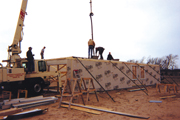

Westchester Development Co., of Shawnee, Okla., is a Native American-owned general contracting company, and has been involved with the Authority for more than 30 years. Chosen for this project, Westchester worked with Royal Building Systems (Cdn) Ltd., of Woodbridge, Ontario, and used the vinyl RBS 4-inch wall in addition to brick veneer installed afterward on the exterior face of the wall. The manufacturer refers to the system as "concrete forming technology." The CFT is a finished stay-in-place concrete form used for load-bearing and non-load-bearing concrete walls. CFT differs from typical ICFs for several reasons, including the CFT are finished on both sides, termite proof, mold and mildew resistant, have integrated channels for running electrical conduit in the walls, and are custom cut at the factory.
"These walls met all the criteria for an environmentally safe and structurally safe house," says Bryan Little, vice president of Westchester. "After the tornadoes, I believe it was time to give this method a try."

Dangerous winds
To help persuade the Authority, Westchester Development built two houses. Not only did it persuade the Authority, it would end up winning a Best Practices Award from HUD for using new and innovative ideas in housing.Westchester sent RBS architectural specifications. RBS did a shop drawing which shows every wall component, all openings, trim, doors and other systems requiring specification. Every component on the drawing is labeled, and a label is attached to the actual component once it is fabricated. The product arrives on the job site finished. Everything is precut-the wall and window openings, notching, heights, etc.
"Construction goes fast because all you have to do is pull it out of the trailer and install it on the slab," says David Saucy, sales manager-USA, of RBS. "One of our principals was to develop a product that a lay person could do so that a contractor, with basic know-how, could put together a structure with minimal effort and in record time."
The CFT has been common in other parts of the world, including the Carribean, where, as with the Shawnee project, the structures are designed to withstand hurricane winds. The main issue preventing its infiltration into the North American market had been code approval.
"Back when I was introduced to it, the material had not gone through BOCA," explains Little. "But they finally got that worked out. I first saw ICFs on a video about 10 years ago and got excited, thinking this was the future of housing."
According to Saucy, concrete is a common housing construction material almost everywhere except North America, with less than 3 percent of housing utilizing this material. Internationally, there are many places in the world prone to disasters, making the CFT desirable for safety concerns.
"These houses utilize the bathrooms as safehouses in the event of a tornado," says Little. "The bathrooms have a concrete lid inside."

Concrete construction
Since this was a new construction process for Westchester, Little took tradesmen into the field and trained them through the first phase of houses on the proper construction procedures."I've been through all phases of it," explains Little. "It's a change, but it's very simple, like putting together a puzzle. Every piece is labeled. Some of the walls are pour-in-place walls, and these go faster. We're getting these walls up in two or three days."
Westchester is actually able to pour a few houses at a time-the pump company comes in and does its job faster.
"The pump companies are talking to the guys doing the foam block saying 'Westchester is pouring two houses of concrete walls a day,' and the foam block guys are saying 'No way,' and the pump guys are saying, 'Yes, they are doing it!'"
Another advantage to the construction includes better energy efficiency. Little claims that these homes cut energy costs in half.
The project started in last September and will be completed in three phases. Phase I occupation is currently underway. Phase II is expected to be completed this month.

Report Abusive Comment